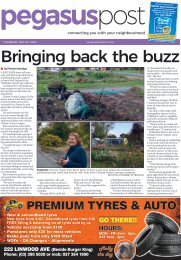03 Magazine: March 01, 2023
Create successful ePaper yourself
Turn your PDF publications into a flip-book with our unique Google optimized e-Paper software.
60 <strong>Magazine</strong> | Travel<br />
What was it with Peter Beaven and Miles Warren?<br />
These two well-known Christchurch architects seemed<br />
to be sparring, on and off, for 30 years?<br />
New Zealand architecture has had few public personalities.<br />
Christchurch had two of them at the same time – Peter<br />
Beaven (1925–2<strong>01</strong>2) and Sir Miles Warren (1929–2022).<br />
They often took opposing sides in heated heritage<br />
debates. Beaven saw himself as being outside the tent,<br />
while Sir Miles was definitely inside. However, they were<br />
both Christ’s College old boys and rather patrician. They<br />
had the confidence of their privileged upbringing, and were<br />
articulate, persuasive and quite willing to make a stand.<br />
There was perhaps a sense that Christchurch was too<br />
small for both of them, but whatever their differences, I<br />
think they always respected each other’s architectural ability.<br />
What’s your favourite Christchurch heritage building?<br />
At the moment, either Mountfort’s Great Hall (1882) at<br />
the Arts Precinct, which really is one of the great rooms<br />
of Aotearoa, or the neighbouring Biology and Physics<br />
Building, with its observatory tower (1896), also designed<br />
by Mountfort, which is now incorporated in a new<br />
boutique hotel.<br />
ABOVE: Public Trust Office, 152–156 Oxford Tce. Cecil Wood (1925).<br />
which was originally the campus of Canterbury College.<br />
There are more than 20 heritage-listed Gothic Revival<br />
buildings at the Arts Centre, and nearly all have now<br />
been faithfully restored.<br />
Some figures emerge from the book as giants of<br />
Christchurch architecture. One is Benjamin Mountfort<br />
– how important was he?<br />
Mountfort was Christchurch’s leading architect from the<br />
time of European settlement in the 1850s until the end of<br />
the 19th century. He set the architectural benchmark for<br />
the new city, and he set it pretty high.<br />
He was fortunate that the style in which he was so<br />
accomplished – Gothic Revival – was the house style of<br />
the Anglican establishment that founded Christchurch,<br />
but the city was also lucky that it was Mountfort who<br />
designed many of its important 19th century buildings.<br />
Who else should be considered as pivotal to the early<br />
fabric of the city?<br />
Mountfort was succeeded in the early 20th century<br />
by a generation of very able architects, including John<br />
Collins and Richard Harman, Samuel Hurst Seager and<br />
Cecil Wood.<br />
The next outstanding era in Christchurch architecture<br />
was the two decades after the Second World War, which<br />
was the heyday of Modernism in the city.<br />
The young Miles Warren was the outstanding<br />
Christchurch architect of this period, but the city had<br />
numerous talented Modernist architecture firms at<br />
this time, and the good old Ministry of Works was<br />
demonstrating its commitment to concrete Brutalism.<br />
Most interesting modern-era buildings?<br />
Miles Warren’s office and apartment (1962) at 65<br />
Cambridge Terrace is still recognisably a little gem of a<br />
building. If you like Brutalism – it’s a taste many people<br />
have not acquired – you’ll appreciate the Centre of<br />
Contemporary Art Toi Moroki (CoCA) Gallery, designed<br />
by the firm of Minson, Henning-Hansen and Dines in the<br />
late 1960s.<br />
Any favourite post-earthquake buildings?<br />
Tūranga, the new Christchurch central city library<br />
(2<strong>01</strong>8) designed by Architectus, Schmidt Hammer<br />
Lassen Architects and the Matapopore Trust is a great<br />
community asset, and Ravenscar House Museum (2021),<br />
designed by Patterson Associates, is a very staunch and<br />
intriguing building.<br />
Anything else to add about Christchurch and<br />
its architecture?<br />
Thanks to its topography and its grid plan, Ōtuatahi<br />
Christchurch is an easy place to walk around. In a couple<br />
of hours, with this guide in hand, you can visit buildings by<br />
nearly all of the city’s significant architects, and take in most<br />
of the design styles deployed over the past 150 years.<br />
Photos by Patrick Reynolds for<br />
Ōtautahi Christchurch Architecture:<br />
A Walking Guide by John Walsh,<br />
Massey University Press, RRP$30.


















